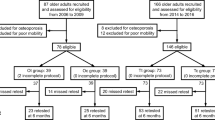Abstract
The purpose of the current study was to design and evaluate the effectiveness of virtual reality training in improving recovery reactions and reducing fall frequency in older adults. Twenty-four older adults were recruited and randomly assigned to two groups (virtual reality training and control). Both groups underwent three sessions including baseline slip, training and transfer of training on slippery surface. Both groups experienced two slips, one during baseline and the other during the transfer of training trial. The training group underwent 12 simulated slips using a visual perturbation induced by tilting a virtual reality scene while walking on the treadmill and the control group performed normal walking during the training session. Kinematic and kinetic data were collected during all the sessions. Results demonstrated a reduced incidence of falls in the training group during the transfer of training trial as compared to the control group. The training group was able to transfer reactive control strategies learned during training to the second slip trial. The reactive adjustments included reduced slip distance. Additionally, gait parameters reflective of gait instability (stride length, step width, variability in stride velocity) reduced after walking in the VR environment for 15–20 min. The results indicated a beneficial effect of the virtual reality training in reducing slip severity and recovery kinematics in healthy older adults.







Similar content being viewed by others
References
Bhatt, T., E. Wang, and Y. C. Pai. Retention of adaptive control over varying intervals: prevention of slip- induced backward balance loss during gait. J. Neurophysiol. 95(5):2913–2922, 2006. doi:10.1152/jn.01211.2005.
Brady, R. A., M. J. Pavol, T. M. Owings, and M. D. Grabiner. Foot displacement but not velocity predicts the outcome of a slip induced in young subjects while walking. J. Biomech. 33(7):803–808, 2000.
Bugnariu, N., and J. Fung. Aging and selective sensorimotor strategies in the regulation of upright balance. J. Neuroeng. Rehabil. 4:19, 2007. doi:10.1186/1743-0003-4-19.
Haibach, P. S., S. M. Slobounov, and K. M. Newell. The potential applications of a virtual moving environment for assessing falls in elderly adults. Gait Posture 27(2):303–308, 2008. doi:10.1016/j.gaitpost.2007.04.004.
Hollman, J. H., R. H. Brey, R. A. Robb, T. J. Bang, and K. R. Kaufman. Spatiotemporal gait deviations in a virtual reality environment. Gait Posture 23(4):441–444, 2006. doi:10.1016/j.gaitpost.2005.05.005.
Jeka, J., K. S. Oie, and T. Kiemel. Multisensory information for human postural control: integrating touch and vision. Exp. Brain Res. 134(1):107–125, 2000.
Kannus, P., H. Sievanen, M. Palvanen, T. Jarvinen, and J. Parkkari. Prevention of falls and consequent injuries in elderly people. Lancet 366(9500):1885–1893, 2005. doi:10.1016/S0140-6736(05)67604-0.
Kennedy, R. S., N. E. Lane, K. S. Berbaum, and M. G. Lilienthal. Simulator sickness questionnaire: an enhanced method for quantifying simulator sickness. Int. J. Aviat. Psychol. 3(3):203–220, 1993.
Keshner, E. A., and R. V. Kenyon. Using immersive technology for postural research and rehabilitation. Assist. Technol. 16(1):54–62, 2004. doi:10.1080/10400435.2004.10132074.
Kottke, F. J., D. Halpern, J. K. Easton, A. T. Ozel, and C. A. Burrill. The training of coordination. Arch. Phys. Med. Rehabil. 59(12):567–572, 1978.
Liu, J., and T. E. Lockhart. Age-related joint moment characteristics during normal gait and successful reactive-recovery from unexpected slip perturbations. Gait Posture 30(3):276–281, 2009. doi:10.1016/j.gaitpost.2009.04.005.
Lockhart, T. E., J. L. Smith, and J. C. Woldstad. Effects of aging on the biomechanics of slips and falls. Hum. Factors 47(4):708–729, 2005.
Lockhart, T. E., J. C. Woldstad, and J. L. Smith. Effects of age-related gait changes on the biomechanics of slips and falls. Ergonomics 46(12):1136–1160, 2003. doi:10.1080/0014013031000139491.
Mansfield, A., A. L. Peters, B. A. Liu, and B. E. Maki. A perturbation-based balance training program for older adults: study protocol for a randomised controlled trial. BMC Geriatr. 7:12, 2007. doi:10.1186/1471-2318-7-12.
Menz, H. B., S. R. Lord, and R. C. Fitzpatrick. Age-related differences in walking stability. Age Ageing 32(2):137–142, 2003.
Nyberg, L., L. Lundin-Olsson, B. Sondell, A. Backman, K. Holmlund, S. Eriksson, and G. Bucht. Using a virtual reality system to study balance and walking in a virtual outdoor environment: a pilot study. Cyberpsychol. Behav. 9(4):388–395, 2006. doi:10.1089/cpb.2006.9.388.
Owings, T. M., and M. D. Grabiner. Step width variability, but not step length variability or step time variability, discriminates gait of healthy young and older adults during treadmill locomotion. J. Biomech. 37(6):935–938, 2004. doi:10.1016/j.jbiomech.2003.11.012.
Pai, Y. C., J. D. Wening, E. F. Runtz, K. Iqbal, and M. J. Pavol. Role of feedforward control of movement stability in reducing slip-related balance loss and falls among older adults. J. Neurophysiol. 90(2):755–762, 2003. doi:10.1152/jn.01118.2002.
Perkins, P. J. Measurement of slip between the shoe and ground during walking. Am. Soc. Test. Mater. 649:71–87, 1978.
Sterling, D. A., J. A. O’Connor, and J. Bonadies. Geriatric falls: injury severity is high and disproportionate to mechanism. J. Trauma 50(1):116–119, 2001.
Sveistrup, H. Motor rehabilitation using virtual reality. J. Neuroeng. Rehabil. 1(1):10, 2004.
Acknowledgments
This research was supported by the NSF (Grant #CBET-0756058) and NIOSH (Grant #CDC/NIOSH-R01-OH009222). Additionally, supported by L30 AG022963-04/NIH HHS/United States.
Conflict of interest
The authors have no conflicts of interest related to this study.
Author information
Authors and Affiliations
Corresponding author
Additional information
Associate Editor Eiji Tanaka oversaw the review of this article.
Rights and permissions
About this article
Cite this article
Parijat, P., Lockhart, T.E. & Liu, J. Effects of Perturbation-Based Slip Training Using a Virtual Reality Environment on Slip-induced Falls. Ann Biomed Eng 43, 958–967 (2015). https://doi.org/10.1007/s10439-014-1128-z
Received:
Accepted:
Published:
Issue Date:
DOI: https://doi.org/10.1007/s10439-014-1128-z




